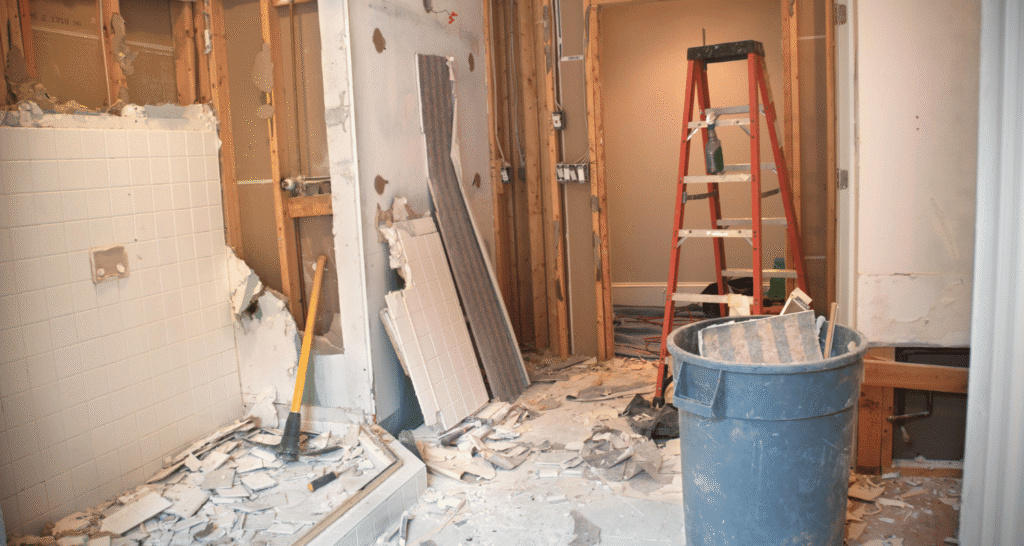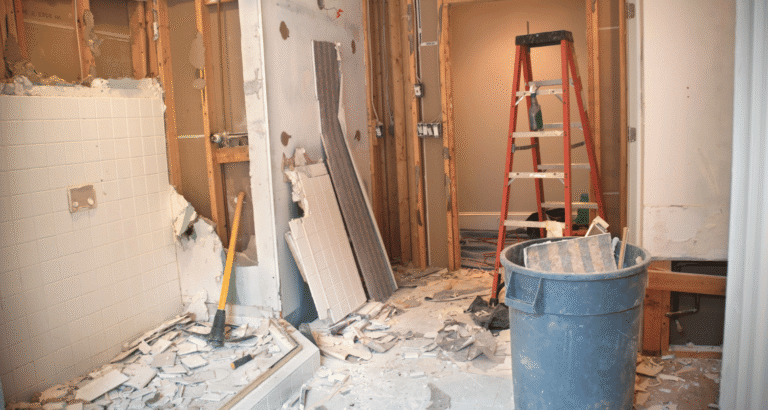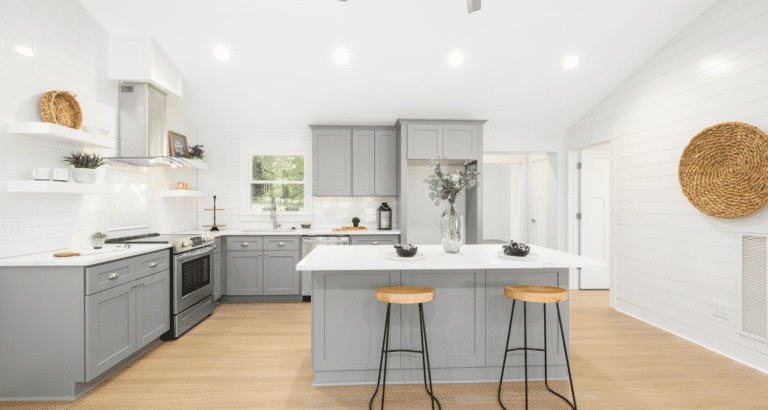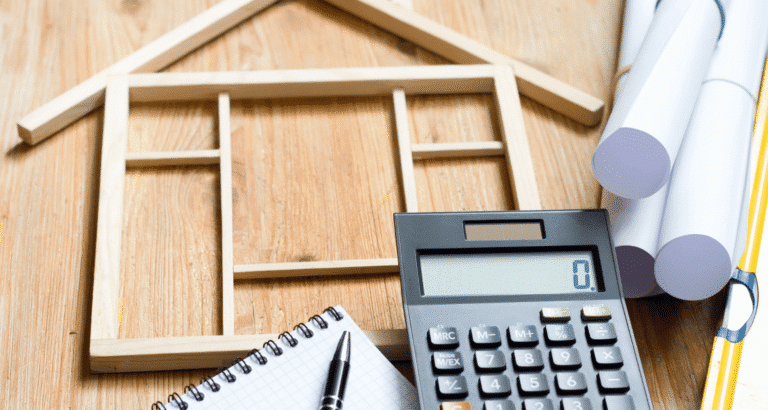A successful bathroom remodel begins with a plan. Use this detailed guide to stay organized and confident at every stage. Whether you’re updating a guest bath or renovating a luxury master bath, this roadmap will lead you step by step.
You’ll learn how to:
- Set a realistic budget
- Assess your space and decide layout
- Choose durable, beautiful materials
- Handle permits and inspections in Dayton / Montgomery County
- Work with local contractors
- Know trending upgrades
- Monitor progress
- Perform a final walkthrough
Design & Style Planning
Start by defining your desired look. Dayton homeowners often prefer either sleek, modern bathrooms or warm, classic traditional styles.
- Modern: clean lines, neutral tones, floating vanities, frameless shower doors
- Traditional: detailed cabinetry, framed mirrors, warm tones, clawfoot or pedestal tubs
Use the NKBA Kitchen & Bath Planning Guidelines for spacing norms and clearances. Visualize your bathroom by collecting tile, vanity, and hardware samples. Even in a tight space, smart design (wall-hung sinks, built-ins, vertical storage) can make your bathroom feel roomy.
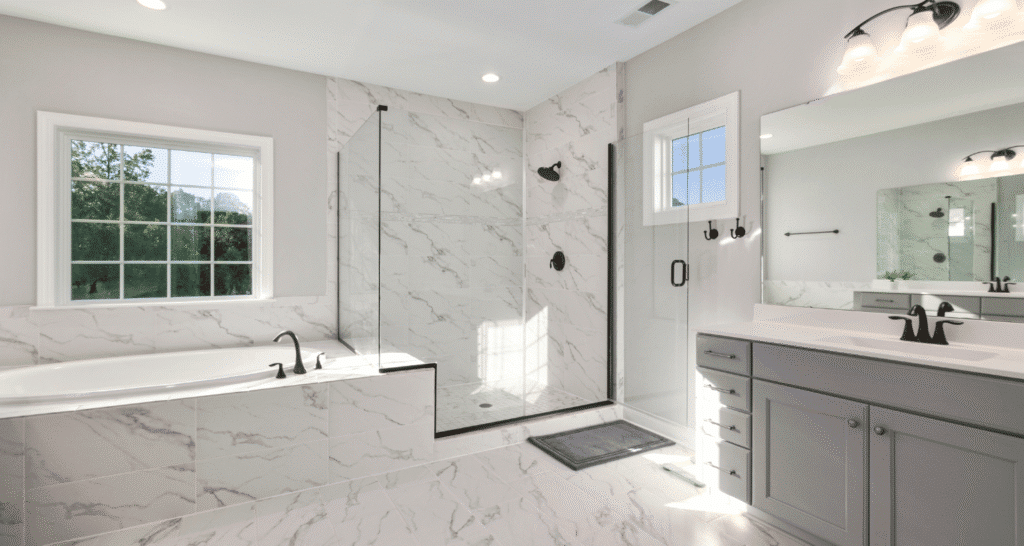
Bathroom Remodeling Pricing Guide for Dayton OH
When planning your remodel, knowing what to expect for different budget levels helps you make smart decisions. At Builders Group Construction, we’ve outlined three main tiers of bathroom remodeling costs based on the average estimated price for a $300,000 home.
Basic Upgrade: $10,000 – $12,000
This option covers essential updates and light improvements. It includes planning, permitting, and basic design options. You might retile your walls and floors or replace an outdated shower, toilet, or vanity. It’s ideal for homeowners who want a fresh look without changing the bathroom’s layout or plumbing setup.
Average Remodel: $22,000 – $28,000
This tier focuses on mid-level upgrades that improve both function and style. It typically includes replacing laminate floors with tile, installing a new vanity and shower system, and adding a new toilet with updated fixtures. Plumbing lines can also be adjusted for a taller shower head or rain shower. This level provides a noticeable transformation while maintaining a reasonable budget.
High-End Renovation: $32,000 – $40,000+
For those wanting a complete transformation, the high-end renovation offers a major overhaul. Walls and ceilings are rebuilt with new finishes, and layouts may change to relocate plumbing or add features like a double vanity or wet room. Custom tile and glass installations, upgraded lighting, and luxury fixtures are included. A separate wet room addition can cost an extra $3,000 to $7,000, depending on materials and design.
Budget Tips
Bathroom remodeling in Dayton can range widely, from cosmetic refreshes around $5,000 to full luxury renovations over $40,000.
Always keep a 10 to 15% contingency for unexpected repairs such as leaks or outdated plumbing. If your initial estimate exceeds your comfort zone, consider keeping your existing layout, choosing mid-grade finishes, or skipping layout changes.
Permits & Local Rules
Before demolition, check whether your remodel needs permits:
- Dayton Building Permit Forms list local permit types and applications.
- Montgomery County’s Projects Requiring Permit covers structural, plumbing or wall changes.
- PHDMC plumbing inspections govern plumbing permits across Dayton & Montgomery County.
If you move drains, add walls, or rewire electrical, you’ll likely need permits. Cosmetic changes (tile, paint, replacing fixtures) typically don’t require them.
Working with Local Contractors
Hire licensed, insured contractors with bathroom experience in Dayton. Ask for references, local project photos, and clear cost breakdowns. Make sure they understand Dayton’s codes and inspection process.
Some local firms to consider: Re-Bath Dayton, Zengel Group, Korrect Plumbing. Including local names helps readers see you aren’t generic, you’re connected to Dayton’s community.
Trends & Innovations to Consider
In modern bathroom design, homeowners are embracing:
- Eco‑friendly materials & low‑flow fixtures
- Natural textures like stone and wood tones
- Barrier‑free showers and universal design features
- Smart plumbing with digital temperature control, programmable showers
- Integrated storage, such as niches and built-in shelving
Bathroom Remodeling Checklist
A bathroom remodel involves many moving parts. This bathroom remodel checklist keeps you organized from day one until the final walkthrough. Follow it step by step to stay on track and avoid surprises.
1. Planning and Preparation
Start with a clear goal. Decide what must change and what can stay. Write down your budget, preferred style, and functional needs. If your project involves plumbing or electrical work, check Dayton’s local permit requirements early. Create a project folder with sketches, quotes, and receipts so nothing gets lost.
2. Budget and Design
Review your finances and set a realistic budget that covers labor, materials, and extras. Add a small cushion for unexpected repairs. Choose a design that fits your home’s style, modern, traditional, or a mix. Collect samples for tiles, paint, and hardware to see how they work together under real light.
3. Materials and Fixtures
List everything you’ll need: vanity, sink, faucet, toilet, lighting, flooring, and hardware. Order items with long delivery times first. Check all fixtures for size and compatibility before installation. For durability, pick moisture-resistant materials designed for bathrooms.
4. Demolition and Inspection
Before removing anything, shut off water and electricity. Carefully take out old fixtures, flooring, and wall coverings. Once cleared, inspect the plumbing, wiring, and subfloor. Repair any weak spots or water damage before new materials go in.
5. Rough‑In Work
Have plumbing and electrical systems roughed in according to your layout. Confirm pipe placement, venting, and power outlet locations. Schedule inspections if required by Dayton or Montgomery County. Proper rough-in ensures a safe, efficient setup.
6. Walls, Floors, and Waterproofing
Install new drywall rated for damp spaces. Apply waterproof membranes in the shower and tub areas. Lay the flooring, then tile or finish the walls. Seal joints and corners to prevent leaks. Let everything cure before adding fixtures.
7. Fixtures, Paint, and Finishes
Install your vanity, sink, and toilet. Mount mirrors, lights, and hardware. Paint walls with moisture-resistant paint in your chosen color. Add final trim and caulk where needed for a clean look.
8. Final Touches and Walkthrough
Turn on the water and test every fixture. Check drainage, lighting, and ventilation. Make sure doors, drawers, and accessories work smoothly. Clean up dust and debris. Once you’re satisfied, your bathroom remodel is complete and ready to enjoy.
Things to Consider Before Hiring a Bathroom Remodeling Contractor in Dayton, OH
Hiring the right contractor makes the difference between a smooth remodel and a nightmare. In Dayton, Ohio, there are specific rules, codes, and best practices to keep in mind. Use the following tips and subheadings to guide your selection.
Licensing, Insurance & Local Permits
First, always confirm that the contractor is licensed and insured in Ohio. Unlicensed work may violate Dayton building codes and cause permit inspections to fail. Ask the contractor to provide:
- Ohio general contractor license (if required)
- Proof of liability insurance
- Workers’ compensation coverage
Also, check their experience specifically with Dayton / Montgomery County permit processes. A contractor familiar with local inspections from PHDMC (Public Health Dayton & Montgomery County) and with City of Dayton building permit forms will save time and frustration.
Portfolio & Local References
Ask to see a portfolio of recent bathroom remodels in Dayton or nearby Ohio suburbs (Centerville, Beavercreek, Kettering, etc.). Visiting local homes or projects helps you judge quality in your climate and code environment. Request references (names and phone numbers) and follow up. A contractor who shows you Dayton area bathroom projects signals confidence in their local work.
Understanding Local Codes & Inspection Schedule
Some bathroom changes require code compliance:
- Plumbing changes must meet PHDMC plumbing inspection rules.
- Electrical upgrades must follow Ohio’s residential electrical codes.
- Drainage slope, venting, and waterproofing need to comply with local standards.
- Inspection scheduling: contractors must arrange inspections with Dayton building officials at key phases (rough‑in, plumbing check, final).
Ask your contractor to explain how they manage inspection timing and how they deal with possible rejections or corrections.
Transparent Contract & Payment Schedule
Before signing, make sure your contract includes:
- Detailed scope: layout, materials, colors, brands
- Line‑item cost estimates (labor, materials, permit fees)
- Allowance for overruns (10‑15% contingency)
- Payment schedule tied to milestones (not full payment upfront)
- Warranty terms for labor and materials
Avoid contractors who demand large sums before work begins. A trustworthy Dayton remodeler will tie payments to completed phases.
Subcontractors & Communication
Many remodelers use subcontractors (plumbers, electricians, tilers). Ask:
- Which work will subcontractors perform?
- Are subcontractors licensed and insured?
- Who coordinates scheduling and quality control?
Also assess communication skills. Good contractors respond promptly, explain steps clearly, and keep you updated. In Dayton, local issues (permits, inspection delays) require clear dialogue.
Timeline, Delays & Material Lead Times
A contractor should offer a realistic timeline. In Dayton:
- Permit approval may delay starting work
- Local supplier stock and delivery times matter (quartz, specialty tile)
- Plan buffer days for humidity, weather, or inspection reschedules
A contract should include a project schedule with start and end dates, and a plan for handling delays.
Dispute Resolution & Cleanup
Finally, ensure there is a plan for:
- Handling disagreements (change orders, cost adjustments)
- Final cleanup and disposal of waste
- Final walk-through and punch list of any issues
In Dayton, some waste disposal haulers require permits; verify who handles debris removal in your contract.
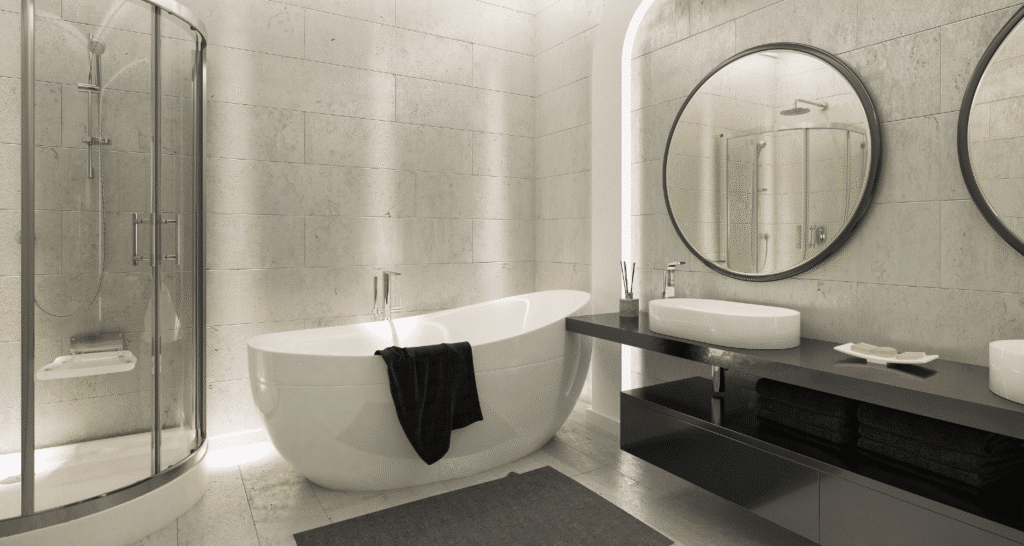
Common Dayton Home Types and Plumbing Quirks
Dayton, Ohio’s housing stock includes a mix of early 1900s homes, post-war builds, and modern constructions. Each era brings its own plumbing quirks, especially in older neighborhoods like South Park, Oregon District, and Five Oaks.
Historic homes, built before 1960, often have original cast iron or galvanized steel pipes. These materials corrode over time, leading to low water pressure, restricted flow, or leaks. Drain lines may clog more easily due to rust and mineral buildup. Some homes may still have clay or lead piping, now considered unsafe or inefficient.
In contrast, mid-century homes (1950s–70s) may use copper pipes, which last longer but can corrode at joints or leak due to poor soldering. Many homes from this era have small bathroom layouts and limited shutoff valves, making remodels more complex.
Modern homes typically feature PVC or PEX systems, lighter, corrosion-free, and easier to repair. But even these can suffer from poor installation or cheap fittings.
When remodeling in Dayton, always inspect the existing plumbing system first, especially in homes over 50 years old. Consider upgrading to modern materials like PEX where possible. And always work with a local pro who understands Dayton’s housing history and current code requirements.
Essential Upgrades & Features
Some upgrades make daily life better:
- Tile flooring: choose water-resistant, durable tile
- Vanities & countertops: quartz or other strong surfaces
- Lighting & ventilation: mix of task and ambient lighting, strong exhaust fan
- Water‑saving fixtures: low-flow toilets, efficient faucets
- Heated floors: caters to cold Ohio winters
- Smart fixtures: LED mirrors, digital controls, touchless faucets
Each of these adds comfort and value. Pairing upgrades with smart design delivers a bathroom that works beautifully for years.
How to Avoid Common Mistakes
- Don’t skip waterproofing, moisture is your worst enemy
- Choose the right size fixtures, don’t force a large vanity into a small footprint
- Order all critical items in one batch, waiting on one item ruins your timeline
- Don’t install wall tile before floor tile, the floor should support the wall edges
- Don’t ignore permits, lateness or violations can stall or reverse your work
Final Walkthrough & Quality Assurance
Before you step away, test every aspect:
- Turn on all faucets and shower, check water pressure and leaks
- Flush toilets, check drainage
- Test lighting and fans
- Open and close doors, drawers, and mirrors
- Inspect grout, caulk lines, and edges
- Clean up debris, dust, and leftover material
This final walkthrough ensures you catch small issues before closing the project.
Can you redo a bathroom for $5,000?
A small bathroom remodel can be done for around $5,000 if you focus on cosmetic updates, like new tiles, paint, and fixtures, and combine DIY work with professional help.
Is $10,000 enough for a bathroom remodel?
Yes, $10,000 can be more than enough for a mid-range bathroom remodel in most Dayton homes. You can change the floor, vanity, and lighting, and even install a new shower with good-quality, budget-friendly materials.
What is the correct order to remodel a bathroom?
The correct flow goes like this: planning and demolition (including disposal of all fixtures); plumbing and electrical work (to avoid leaks and other problems down the road); wall preparation and a fresh coat of paint; new flooring (a rough-and-ready surface is fine for now); wall finishes such as paneling or tiling; install fixtures that will be used daily (like sinks and showers); painting touch-ups afterward.
What is a realistic budget for a bathroom remodel?
The average budget for a bathroom remodel is between $8,000 and $25,000, depending on the size of your bathroom, the quality of the materials you use, and your labor costs. Smaller updates are less expensive, while luxury finishes or a layout change add to costs.

